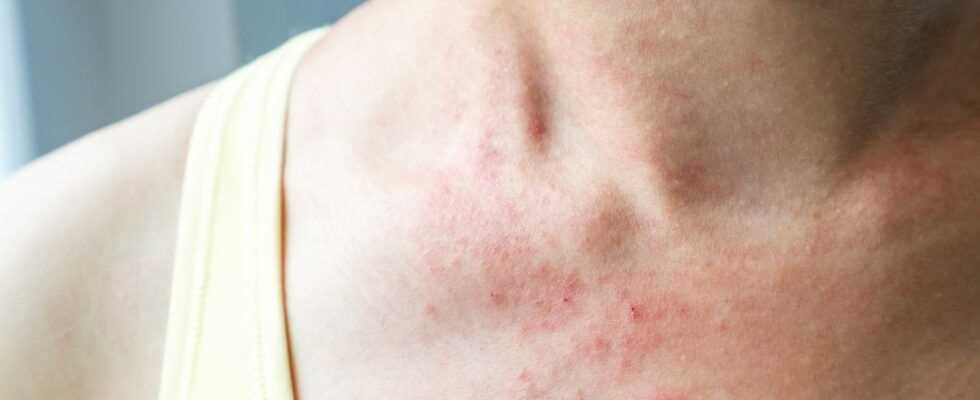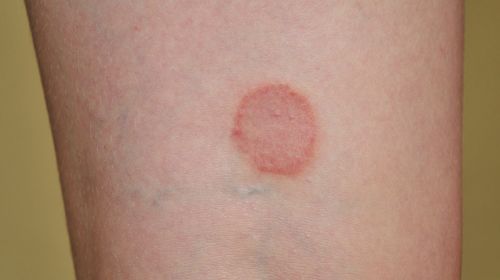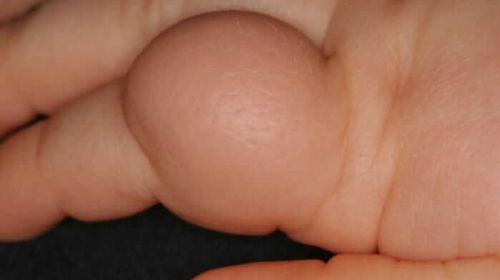Red spots, pustules, nodules or wheals – a rash can take many forms and is a common symptom of various diseases. The appearance of the rash indicates whether a virus infection, allergy or even parasites are possible triggers.
A variety of different, temporary skin changes are summarized under the term rash. However, permanent skin changes, such as liver spots, are not called a rash.
A rash (rash) usually occurs suddenly. It is a common symptom: Hardly anyone is spared their entire life from red spots, wheals or blisters. The proportion of patients who go to a family doctor's office because of an itchy rash is between five and ten percent.
Depending on the type and cause of the rash, a small area of the skin, a larger area of the skin or the entire body may be affected.
As varied as the extent and appearance of rashes, the causes are also different. A rash can be a symptom of an infectious disease, an allergic reaction, or a parasitic skin disease. As a side effect of medication, there can be temporary changes in the appearance of the skin (drug rash).
Red spots on the skin usually have a harmless cause, but can also be a symptom of shingles, wheezy glandular fever, syphilis or hepatitis. If the skin changes itch at the same time, there is often an allergy behind it. The body can also react to infections with viruses or bacteria with red spots.
Signs of the rash: spots, pustules, or tears
A rash is often initially expressed as skin bumps such as small nodules, pustules or wheals. However, it can also appear in the form of red spots without bumps or swellings, or it can show through cracks or recesses in the skin. Skin layers such as dandruff or crusts are also possible.
What types of rash are there?
There are different basic forms of skin rash, depending on the appearance.
1. Skin elevations
Nodules (papules): skin elevation with a diameter of less than 5 mm
Knot (nodus): skin elevation with a diameter of more than 5 mm
Plaque: flat skin elevation with a diameter of up to 10 cm
Vesicles: fluid-filled bump with a diameter of less than 5 mm
Bladder (bulla): fluid-filled bump with a diameter of more than 5 mm
Pustule (pustula): skin raised with pus
Wheal (Urtica): bed-like elevation with fluid retention in the tissue (edema) and a diameter between 0.2 and 10 cm
swelling
2. Skin depressions
Erosion: superficial skin injury
Excoriation: deep skin injury
Ulcer: Chronic deep skin injury
Crack (Rhagade)
3. Skin layers
Dandruff (squama): contiguous areas of detaching epidermis
Crust (Crusta): dried liquid
Fluid: Blisters or wheals filled with fluid
4. Rash without elevation or deepening
- Stain (flaw): circumscribed color change
Other criteria by which rash is characterized:
Skin redness (erythema): red spots on the skin
Skin coarsening (lichenification): the normal fine field of the skin is eliminated
Arrangement of skin changes: for example grouped, scattered or flowing together
Form of arrangement: for example linear or circular (anular)
Skin change sensation: for example, burning or itchy skin
Rash: cause red spots, pustules and wheals
A rash itself is not a disease, but a symptom of an underlying disease. Sometimes researching the cause can be like looking for a needle in a haystack: from psychosomatic triggers to allergies and intolerance reactions to infectious diseases and internal diseases, there is a wide range of triggers for a rash.
-

Fever, pain, shortness of breath: Look specifically for symptoms and their possible triggers
for symptom check
Overview of possible causes of rash
Viral infections and typical teething problems
infectious diseases caused by bacteria
Allergies and intolerance reactions such as
Rheumatic diseases, autoimmune diseases such as
Infestation by parasites or mycoses (fungal disease) such as
- Fungal infections (e.g. athlete's foot)
- Scabies (scabies): The cause of the parasitic skin infection are itch mites, which penetrate the skin and cause very itchy, pin-sized bubbles (vesicles) and small nodules (papules). Even after the itch mites have been treated and removed, the rash can persist for weeks.
- Bad dermatitis
Rash: this is the diagnosis
The distribution and appearance of the skin changes are often so typical that dermatologists (dermatologists) can in many cases derive the cause of a rash solely from its appearance and from typical accompanying symptoms.
In the doctor-patient discussion, the focus is on the temporal development of the rash (since when has the rash been present? Is it continuous or does it worsen in certain situations?) And the accompanying symptoms. In addition, the doctor will ask about previous illnesses, trips abroad, allergies and medication intake and inquire about similar illnesses in the patient's environment.
During the physical examination, the doctor checks general symptoms such as fever or fatigue and the condition of the internal organs. The skin areas are examined closely with an illuminated magnifying glass or a glass spatula in order to precisely assess and describe the skin changes. As a rule, the entire body surface including the eyes and, if necessary, the mucous membranes of the nose, mouth and genitals are examined.
Blood test and biopsy
With a rash, immunological factors can play a role. This is why blood tests provide evidence of inflammatory processes or the involvement of the body's defense system. If the attending physician suspects a contact or food allergy as the cause of the rash, the trigger can be narrowed down and identified by a skin test (prick test) or by the determination of certain blood components.
The histological examination of a tissue sample (biopsy) provides information about which changes at the cell level led to the rash.
The cause of the rash can rarely be clarified, in this case doctors speak of an idiopathic rash.
How is a rash treated?
In many cases, a rash is due to infections with viruses or bacteria. While bacterial infections can usually be combated effectively with antibiotics, the therapy of a rash caused by viruses is more difficult. So far, there is only the possibility for some of these diseases to target the triggering viruses with drugs, for example for herpes infections and chickenpox. For other viral diseases, treatment is limited to alleviating the symptoms.
If the rash was triggered by a fungal infection, antifungals are available. Medications can also be used to treat skin rash due to an allergy. Basically, allergen avoidance (avoiding contact with the respective allergen) plays an important role in the treatment of allergies. In the event of skin reactions to a medication, for example in the form of red spots, the medication in question should be discontinued in consultation with the doctor and replaced with a better tolerated preparation.
Rashes can also result from the body's autoimmune reactions. If there is a disease of the rheumatic type or the immune system, treatment is given with drugs that influence the activity of the body's defense. These include anti-inflammatory, cortisone or immunosuppressive agents.
Creams relieve itchy rash
In addition to treating the cause, the symptoms can also be alleviated: special ointments and creams reduce itching and promote healing of the skin. Depending on the form of the rash, skin care creams to regulate the moisture balance can also support the therapeutic success of a rash.



